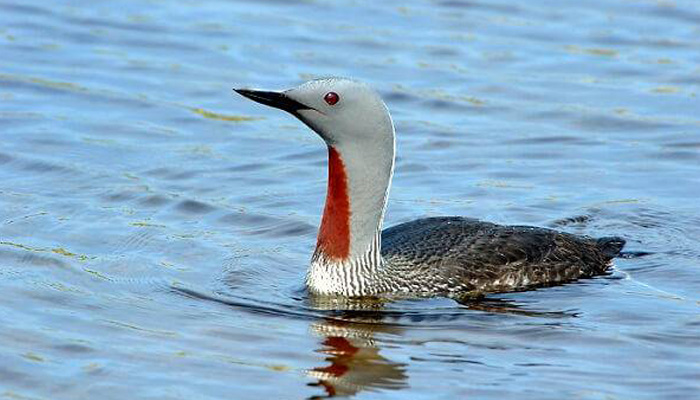
English: Red-throated Loon
Russian: Краснозобая
гагара
German: Sterntaucher
French: Plongeon catmarin
Mongolian: Улаангүеэт
гахууна, Улааномруут ахууна
Japanese: アビ (Abi)
Body length: 55-67cm
Wing span: 91-110 cm
Habitat: Commonest loon in most regions. Breeds on often small
and fishless pools on tundra or on forest bogs, commuting to larger lakes or
coast for food.
Identification: Smallest loon, but only slightly
smaller than Black-throated. Bill uptilted with straight culmen, usually held
pointing slightly upwards. Forehead flat, and inclination to have angled hindcrown.
Usually noticeably flat-chested (useful esp. at long range; Black-throated has
prominent chest). In flight, look for slimmer neck; also more ‘sagging’ neck
giving hunchbacked impression; bill often pointing slightly upwards even in flight;
usually modest foot projection, making wings set behind centre (but a few have
feet projection more, as on Black-throated); generally somewhat faster and
deeper wingbeats than Black-throated in comparable winds; and rather common
habit of moving head as if ‘calibrating vision’ (Black throated does this only
infrequently).
- Adult summer: Rufous neck patch is dark, and can look
black at a distance, so (pale) grey throat and plain upperparts best long-range
marks.
- Adult winter: In profile, more than half of neck is
white, visible in flight too, and, seen from behind, some white visible on
sides of neck (Black-throated usually entirely dark-necked from rear), and a
little white surrounds eye; whole upperparts finely speckled with white. Flanks
show as a complete pale band (mottled) above waterline (if any pale visible),
usually not as a conspicuous white patch at rear.
- Juvenile: As adult winter, except white areas on head
and neck have fine, dusky streaking (often
extensive) not pure white, and upperparts have duller, greyer speckling.
- 1st summer: Summer plumage only partial. Often twin
dark stripes on foreneck in transition.